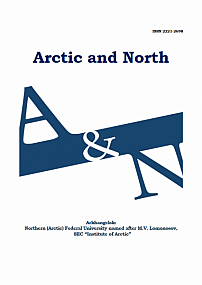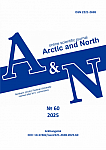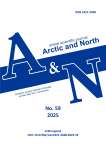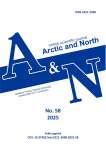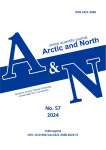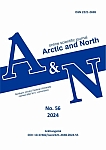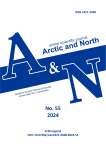Arctic and North
Indexing of the journal “Arctic and North”: EBSCO Publishing, USA, Directory of Open Access Journals — DOAJ, Global Serials Directory Ulrichsweb, USA, NSD, Norway, InfoBase Index, India, ERIH PLUS, Norway, MI-AR, Spain, OAJI, RSCI based on Web of Science. The journal is issued not less than 4 times a year.
The journal “Arctic and North” (also known as “Arktika i Sever”) is registered at Roskomnadzor (Federal Service for Supervision in the Sphere of Telecom, Information Technologies and Mass Communica-tions) as an online media published in Russian and English: Registration certificate ЭЛ No. ФС77- 78458, issued on the 8th of June 2020. Earlier, the journal was registered as an electronic periodical, certificate ЭЛ No. ФС77-42809 dated November 26, 2010
The journal is designed for professionals and a wide range of readers, both in Russia and abroad; it is issued both in Russian and English (translated by the Editorial staff).
The journal is focused on the results of studies, research papers, reviews, etc. joined by the Arctic or Northern theme, in following areas of knowledge:
- Economics;
- Social studies;
- Political science.
The Editorial Board of “AaN” is committed to the policy of openness and accessibility. Since September 2016, the journal has CC BY-SA license. All articles are checked by the Antiplagiat system. The service is designed to check text documents for borrowings.
The policy of "Arctic and North" helps to ensure that published articles and reviews are in demand for research, PhD dissertation, state and municipal management, policy making and the development of the northern regions.
Northern (Arctic) Federal University named after M.V. Lomonosov
Выпуски журнала
Статьи журнала

Статья научная
The article discusses the problems of increasing the multiplier effect of the agro-industrial complex of the Komi Republic as a result of investment, as well as ways to accelerate the economic growth of its spheres and individual enterprises. The problems of motivation to increase capital investments in order to increase production and competitiveness of marketable products remain without due attention. The aim of the study is to substantiate the transition of the agro-industrial complex of the Komi Republic to an innovative and investment path of development, to more active methods of using advanced technologies and resource provision of investments, increasing the share of the intellectual component in their composition. The subject of the study is to determine the level of the multiplier effect of the agro-industrial complex of the Komi Republic as a method for assessing its effectiveness and competitiveness. Research methods — quantitative assessment of the effectiveness of total costs, scientific abstraction, analysis and synthesis, systems approach, historical and logical method, statistical observations. The article reveals the main trends of the multiplier effect in the agro-industrial complex of the Komi Republic. It is proposed to increase the multiplier effect of the agro-industrial complex for business entities to focus on the tasks of coordinating the flows of available investment resources.
Бесплатно
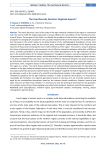
The Food Security Doctrine: Regional Aspects
Статья научная
The article discusses issues of the state of the agro-industrial complex of the region in connection with the need to fulfill the targets approved in January 2020 by the new edition of the Food Security Doctrine of Russia. The purpose of the study is to identify the problems of the northern region and to develop proposals for changing the situation for the successful implementation of the Doctrine. The scientific problem discussed in the article relates to the determination of the methodological foundations of the most relevant areas of agrarian policy for the current state, ensuring the implementation of the Food Security Doctrine of Russia and increasing the level of self-sufficiency of the region. The author's research develops the theory of determining the socio-economic role of effective interaction between authorities of different levels, scientific justification of the prospects for the further development of the agro-industrial complex due to the transformation of the industry development management system, innovative approach to training personnel for the agricultural sector, and introduction of new technological solutions as highly relevant. It has been established that such factors as the lack of effective interaction between the state and municipal authorities, and also the lack of young qualified personnel, whose competence meets the modern requirements, have a negative impact on the economy of agricultural production and food self-sufficiency of the region as a whole. The article draws attention to the underestimated opportunities for improving the situation in the agro-industrial complex due to a change in the scheme of interaction between the state and municipal authorities during the implementation of the program-targeted method of regulation and strategic planning, as well as the creation of a scientific and educational complex in the region for the training of competitive specialists for the agro-industrial complex. In order to improve the situation, it is necessary to consolidate the formation of a regional agricultural system on the basis of a set of similar systems developed by the municipalities themselves, based on the relevant climatic conditions, financial, material and labor resources of these areas. Besides, it is necessary to start the training of personnel for the agroindustrial complex system from school, applying new educational standards, based on scientific developments.
Бесплатно
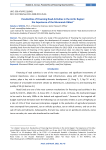
Статья научная
The article presents the results of a study of the peculiarities of financing the road economy of the Murmansk Oblast — the Arctic region, the development of transport, including road, infrastructure of which acquires particular importance in the light of the implementation of national interests and priority directions of Russian state policy in the Arctic. In the course of work, the author considered the dynamics of spending funds from the Road Fund of the Murmansk Oblast for 2012–2020. It has been determined that the existing volume of financing of the regional road infrastructure does not allow the region to fully implement the tasks of developing road infrastructure and improving the quality of highways (primarily local ones). It is concluded that additional funds are needed to finance the road infrastructure of the Arctic regions, including through the use of public-private partnership mechanisms. The results of the study can be used in the formation of a policy in the field of road facilities in the Murmansk Oblast, as well as in further research on the financial support of road activities and the functioning of road funds.
Бесплатно
Reindeer Tracking Technologies in the Russian Federation
Статья научная
Currently, reindeer husbandry actively uses tracking technologies to identify animals. They allow solving the problems of breeding and zootechnical accounting, tracking the movement of animals between herds, and carrying out antiepizootic measures. The electronic databases with individual characteristics of reindeer formed in this process allow speeding up the breeding process, organising breeding work in reindeer breeding, improving the breed and regulating the herd. Keeping an electronic “registration” of calves to their mothers gives the possibility of system functioning of cross-breeding estimation of animals that will undoubtedly increase both productivity and economic efficiency of reindeer breeding as a whole. This article addresses an issue related to reindeer tracking technologies. Attention is paid to radio tracking and satellite tracking techniques. The use of modern methods of chipping animals is considered on the example of various territories of the Russian Federation: the Yamalo-Nenets Autonomous Okrug, the Republic of Sakha (Yakutia), the Trans-Baikal Krai, the Murmansk Oblast, the Krasnoyarsk Krai, the Republic of Karelia, the Arkhangelsk Oblast. The work carried out on deer chipping is considered for various time periods, during which monitoring, programs, projects and other large-scale studies of animal movement paths were carried out. The resulting data can then be processed using mathematical tools, after which conclusions can be drawn about the impact of the environment on reindeer migration routes.
Бесплатно
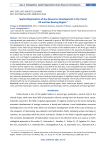
Spatial Organisation of Gas Resources Development in the Yamal Oil and Gas Bearing Region
Статья научная
The Yamal oil and gas province (OGP) is strategically important for the Russian gas industry. In the coming decade, gas production in Yamal is expected to grow to 180–200 billion cubic meters per year. The main goal of the article is to solve a scientific problem consisting in the study of the spatial organization of the development of gas resources, determination of the rational structure of reproduction of natural gas reserves in the Yamal oil-gas-bearing region in the context of the modernization of the Arctic gas industry complex. The article assessed the gas resources of Yamal, revealed trends in the economic development of natural gas fields, presented the characteristics of investment projects based on the fields being developed. An analysis was carried out that made it possible to differentiate the deposits by the degree of their prospects, and a strategy for expanding the hydrocarbon potential of Yamal was determined. It was revealed that the main areas of production in the Yamal oil-gas-bearing region are associated with the development of deposits with a high level of Cenomanian deposits. Such deposits are characterized by a higher increase in the capitalization and profitability of investment projects in real time compared to fields located in the northern and far eastern seas, including on the shelf of the Kara Sea. It was concluded that the strategy for the reproduction of hydrocarbon potential will be aimed at conducting prospecting and exploration in order to transfer forecast resources to industrial reserves of natural gas. The study applies a general scientific methodology providing for systemic and comprehensive approaches to justify the spatial organisation of gas resources development in the Yamal oil and gas bearing region. A significant body of factual material on the state of free gas and condensate reserves in Yamal has been analyzed. The results of the research were obtained with the use of comparative-analytical, statistical methods of economic analysis.
Бесплатно
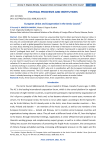
European Union and Cooperation in the Arctic Council
Статья научная
Since 2008, the European Union has unsuccessfully tried to obtain permanent observer status in the Arctic Council, the central cooperation forum in the Arctic. The analysis shows that the EU's failures in this area are connected both with its location mostly outside of the region and remoteness from the northern realities, as well as global geopolitical tensions. However, the EU has had de facto observer ad hoc status since 2013, allowing it to participate in almost all formats of interaction in the Arctic Council. Considering this fact, the permanent observer status has rather a symbolic meaning and is equivalent to joining a kind of “privileged Arctic club”. An analysis of the EU's functioning in its relations with the Arctic Council and its members shows that the EU is ready to adapt and listen to the opinion of the Arctic countries in order to become a legitimate Arctic actor. The Arctic Council is of uneven importance for the different EU member states: Denmark, Finland and Sweden are full members, several countries are permanent observers, but most EU countries are not interested in the Arctic issues. Because of this multifaceted nature, the collective EU is more of an extra-regional player on the platform, but one with serious Arctic claims. The EU is actively working on a common Arctic policy. It is represented in the Arctic Council by the Ambassador-at-Large for Arctic Affairs, introduced in 2017, who acts in coordination with the European Commission and the member states concerned. The EU's overall approach is not unsuccessful: it has managed to engage more member states on the Arctic vector, and European expertise and input on sustainable development issues is already becoming an integral part of the AC's work and promises to evolve further.
Бесплатно

